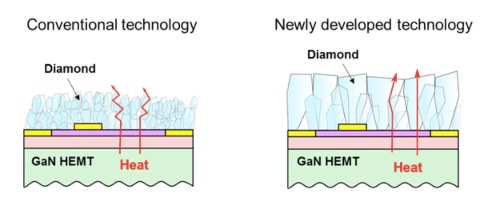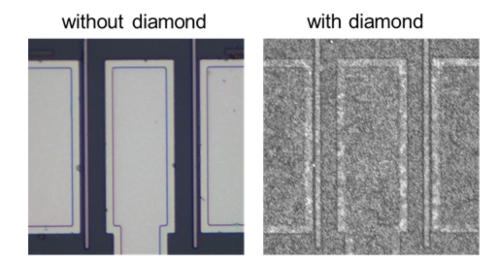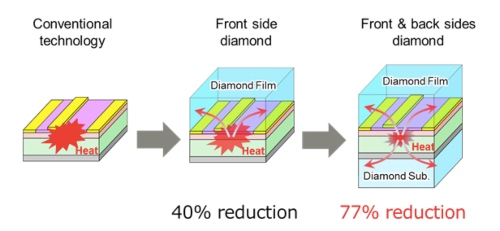- News
16 December 2019
Fujitsu grows diamond film to boost heat dissipation efficiency of GaN HEMT
At the 2019 MRS Fall Meeting in Boston, MA, USA (1-6 December), Fujitsu Ltd and Fujitsu Laboratories Ltd reported what is reckoned to be the first technology for growing a diamond film with highly efficient heat dissipation on the surface of gallium nitride (GaN) high-electron-mobility transistors (HEMTs).
Development background
In recent years, GaN HEMTs have been widely used as transistors for high-frequency amplifiers in weather radar and wireless communications equipment. In the future, achieving breakthroughs in areas like the highly accurate observation of localized torrential downpours and the creation of a stable millimeter-wave high-speed communication environment for 5G communications will require considerably increased deployed of radars and base stations worldwide.
However, the limitations inherent to existing designs continue to prevent an increase in the number of installations. The transistors used in radar systems have higher output power due to the need to operate over- greater distances, which increases the amount of heat they generate. Cooling equipment is required because of the performance degradation caused by overheating. This remains expensive, and the large size of the entire system, including the cooling apparatus, limits the installation location, making simplification and miniaturization of the cooling equipment an important challenge for designers.
Challenges
One way to reduce the size and complexity of the cooling system is to increase heat dissipation efficiency by covering not only the back surface of the GaN HEMT but also the front surface with a diamond film. This diamond film, which possesses excellent heat dissipation properties, would effectively lower the internal temperature of the GaN HEMT. To achieve this, however, a diamond crystal with large grain size is required to pass heat efficiently so that heat does not accumulate inside the diamond.
To grow such a diamond film, a high temperature of about 900°C is usually required, which unfortunately destroys the GaN HEMT underlying the diamond growth. When a diamond film is grown at low temperature (~650°C, at which the GaN HEMT is not destroyed), the resulting reduction in thermal energy given to the methane gas used to create the diamond means that growth of the diamond is incomplete. Using the low-temperature method, it is only possible to grow microscopic diamond particles (or nanodiamonds) of several hundred nanometers or less. Furthermore, each particle becomes an aggregate of crystals facing different directions, which inhibits efficient heat transfer between particles (Figure 1).

Newly developed technology
To address this challenge, Fujitsu has developed a technology for growing a highly heat-spreading diamond film at low temperatures (about 650°C) where transistors are not destroyed and, in what’s claimed to be a world first, succeeded in demonstrating the operation of a GaN HEMT with a highly heat-spreading diamond film on its surface.
To grow the diamond film with this method, nanodiamond particles with a diameter of several nanometers are placed on the entire surface of the device. The nanodiamond particles are then exposed to methane gas with high thermal energy to convert the carbon contained in the methane gas into diamond, which can then be incorporated into the particles. Carbon, with its high energy, is selectively incorporated into diamonds that point in a particular direction, allowing diamonds that point in the same direction to bond together and grow.

Focusing on the fact that the thermal energy given to methane varies depending on the pressure and the concentration of methane gas during diamond growth, Fujitsu discovered that nanodiamond particles oriented in a specific direction can be selectively enlarged at low temperatures. This makes it possible to convert a nanodiamond into a micron-sized diamond 1000 times larger (Figure 2). As a result, heat can easily pass through the diamond and the GaN HEMT can dissipate heat efficiently.
Outcome
By using the newly developed technology, the amount of heat generated during GaN HEMT operation is reduced by about 40% compared to without diamond film, and the temperature can be lowered by 100°C or more. Furthermore, by combining heat dissipation from the backside of the GaN HEMTs with single-crystal diamond developed by Fujitsu and silicon carbide (SiC) bonding technology at room temperature, the front and back sides of the GaN HEMTs can be covered with a diamond film, which should reduce heat generation by about 77% (Figure 3).

This can enable the use of small cooling devices for high-performance radar systems that previously required large cooling devices, saving space and making it significantly easier to install the larger number of units needed for applications including improved weather forecasting and 5G communications, reckons Fujitsu.
The research was partially supported by the Innovative Science and Technology Initiative for Security, established by the Acquisition, Technology & Logistics Agency (ATLA) of the Japanese Ministry of Defense.
Going forward, Fujitsu aims to commercialize its new high-heat-dissipation GaN HEMT amplifiers in fiscal 2022 for use in weather radar systems and next-generation wireless communication systems.
Diamond thermal management boosts output power of InAlGaN transistor
Diamond thermal management GaN HEMT


